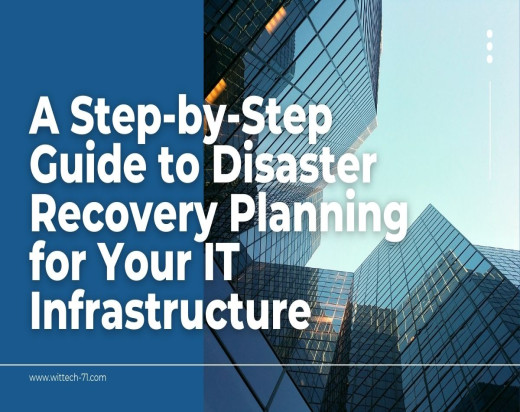A Step-by-Step Guide to Disaster Recovery Planning for Your IT Infrastructure
In today's digital age, businesses rely heavily on their IT infrastructure to operate efficiently and effectively. However, disasters can strike at any time, ranging from natural calamities like earthquakes and floods to man-made incidents such as cyberattacks or hardware failures. Without a comprehensive disaster recovery plan, your business can face significant downtime, data loss, and financial setbacks. In this step-by-step guide, we'll walk you through the process of creating a disaster recovery plan to safeguard your IT infrastructure and ensure business continuity.
Step 1: Understand the Risks
The first and most critical step in disaster recovery planning is to identify potential risks and threats that could impact your IT infrastructure. These risks may include:
- Natural Disasters: Such as earthquakes, floods, hurricanes, and fires.
- Human Error: Accidental data deletion, misconfigurations, or improper handling of equipment.
- Cyberattacks: Including malware, ransomware, and data breaches.
- Hardware and Software Failures: Servers, storage devices, or software crashes.
Conduct a comprehensive risk assessment to determine which threats are most relevant to your organization.
Step 2: Define Your Objectives
Clearly define the objectives and goals of your disaster recovery plan. These objectives should include:
- Recovery Time Objective (RTO): The maximum acceptable downtime for each critical system.
- Recovery Point Objective (RPO): The maximum amount of data loss your organization can tolerate.
- Minimal Service Level: Specify the minimum level of service required to maintain business operations during a disaster.
These objectives will serve as the foundation for developing your recovery strategies.
Step 3: Identify Critical Assets and Data
Determine which assets and data are critical for your business operations. This includes financial records, customer information, proprietary software, and other essential resources. Prioritize these assets based on their importance to your organization.
Step 4: Develop a Disaster Recovery Team
Assemble a disaster recovery team responsible for creating and executing the plan. This team should include individuals with technical expertise, as well as representatives from various departments across your organization. Assign specific roles and responsibilities, and ensure all team members understand their roles in case of a disaster.
Step 5: Data Backup and Recovery
Implement a robust data backup and recovery strategy. This includes:
- Regularly backing up critical data and systems.
- Storing backups offsite to protect against physical disasters.
- Testing backup restoration procedures to ensure data integrity.
- Automating backup processes to minimize human error.
Step 6: Disaster Recovery Site
Establish a secondary location, known as a disaster recovery site or data center, where you can replicate your IT infrastructure. This site should be physically distant from your primary location to minimize the risk of both locations being affected by the same disaster. Ensure the site is equipped with the necessary hardware, software, and network connectivity.
Step 7: Create a Communication Plan
Develop a clear and effective communication plan to ensure that your disaster recovery team, employees, and stakeholders are well-informed during a disaster. This plan should include:
- A list of contact information for all team members and stakeholders.
- A designated spokesperson responsible for communicating with the media and external parties.
- Procedures for notifying employees and stakeholders about the disaster and recovery efforts.
Step 8: Document Procedures
Document all disaster recovery procedures in detail. Include step-by-step instructions for recovering critical systems and data. This documentation is invaluable during the high-stress environment of a disaster, ensuring that team members can follow established processes.
Step 9: Regular Testing
Regularly test your disaster recovery plan to identify weaknesses and areas for improvement. Testing should encompass:
- Full-scale disaster recovery drills.
- Partial recovery tests, focusing on specific systems or data.
- Tabletop exercises, which are discussions of hypothetical disaster scenarios.
Testing helps refine your plan and ensures that your team is well-prepared for real-world disasters.
Step 10: Employee Training
Invest in employee training to ensure that your staff understands their roles and responsibilities in the event of a disaster. Provide guidance on evacuation procedures, data backup protocols, and the use of recovery tools and resources.
Step 11: Review and Update
Periodically review and update your disaster recovery plan. Technology and business processes evolve, so your plan should adapt to these changes. Regularly revisit your risk assessment and objectives to ensure they align with the current state of your organization.
Step 12: Documentation and Reporting
Maintain comprehensive records of your disaster recovery plan, testing results, and any real-world disaster incidents. This documentation can be invaluable for compliance, reporting, and continuous improvement.
Conclusion
Disaster recovery planning is a critical element of ensuring business continuity and protecting your IT infrastructure. By following this step-by-step guide, you can create a comprehensive disaster recovery plan that addresses potential risks, identifies critical assets, and outlines recovery strategies. Regular testing and updates will help keep your plan relevant and effective in the face of evolving threats and technology. With a well-prepared disaster recovery plan, your organization can minimize downtime, data loss, and financial impact in the event of a disaster, ultimately ensuring the resilience of your IT infrastructure and the continued success of your business.





Comments